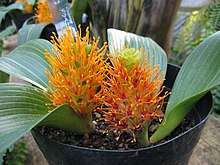Daubenya
Daubenya is a genus of bulbous flowering plants in the family Asparagaceae, subfamily Scilloideae (also treated as the family Hyacinthaceae).[2] It is native to the Cape Province of South Africa.[1]
| Daubenya | |
|---|---|
 | |
| Daubenya ?marginata in cultivation in Japan | |
| Scientific classification | |
| Kingdom: | Plantae |
| Clade: | Tracheophytes |
| Clade: | Angiosperms |
| Clade: | Monocots |
| Order: | Asparagales |
| Family: | Asparagaceae |
| Subfamily: | Scilloideae |
| Genus: | Daubenya Lindl.[1] |
Description
Species of Daubenya grow from bulbs covered with a brownish tunic. Each bulb produces only two leaves, which appear with the flowers and normally spread out along the ground on either side. The inflorescence is a raceme, usually very condensed and close to the ground. Individual flowers are white, pink, yellow or red, sometimes with the tepals furthest from the flowering stem (i.e. on the outside of the inflorescence) larger than the others. The tepals are fused at the base forming a distinct tube. The stamens arise from the mouth of this tube, and are often very prominent. The more or less globe-shaped black seeds are produced inside a papery capsule.[3][4]
Species
As of March 2013, the World Checklist of Selected Plant Families recognized eight species:[5] All but D. aurea were transferred to the genus Daubenya during revisions of the South African members of the Scilloideae in early 2000s; they were previously placed in Androsiphon, Amphisiphon, Polyxena, Massonia, or Neobakeria.[6]
- Daubenya alba A.M.van der Merwe
- Daubenya aurea Lindl.
- Daubenya capensis (Schltr.) A.M.van der Merwe & J.C.Manning (syn. Androsiphon capensis Schltr.)
- Daubenya comata (Burch. ex Baker) J.C.Manning & A.M.van der Merwe (syn. Massonia comata Burch. ex Baker)
- Daubenya marginata (Willd. ex Kunth) J.C.Manning & A.M.van der Merwe (syn. Massonia marginata Willd. ex Kunth)
- Daubenya namaquensis (Schltr.) J.C.Manning & Goldblatt (syn. Neobakeria namaquensis Schltr.)
- Daubenya stylosa (W.H.Baker) A.M.van der Merwe & J.C.Manning (syn. Amphisiphon stylosus W.H.Baker)
- Daubenya zeyheri (Kunth) J.C.Manning & A.M.van der Merwe (syn. Massonia zeyheri Kunth)
References
- "Daubenya", World Checklist of Selected Plant Families, Royal Botanic Gardens, Kew, retrieved 2013-03-28
- Stevens, P.F. (2001 onwards), "Asparagales: Scilloideae", Angiosperm Phylogeny Website, retrieved 2013-03-28
- "Daubenya Raf.", eMonocot, retrieved 2013-03-28
- Daubenya, Pacific Bulb Society, retrieved 2013-03-29
- Search for "Daubenya", World Checklist of Selected Plant Families, Royal Botanic Gardens, Kew, retrieved 2013-03-28
- Manning, J.C.; Goldblatt, P. & Fay, M.F. (2004), "A revised generic synopsis of Hyacinthaceae in Sub-Saharan Africa, based on molecular evidence, including new combinations and the new tribe Pseudoprospereae", Edinburgh Journal of Botany, 60 (3), doi:10.1017/S0960428603000404
External links
- Cumbleton, Paul, "Log 9 22nd Nov 2007", Wisley Alpine Log, Scottish Rock Garden Club, archived from the original on 2013-03-29, retrieved 2013-03-29 – photographs of six species
- "Daubenya", Pacific Bulb Society, retrieved 2013-03-29 – photographs of seven species